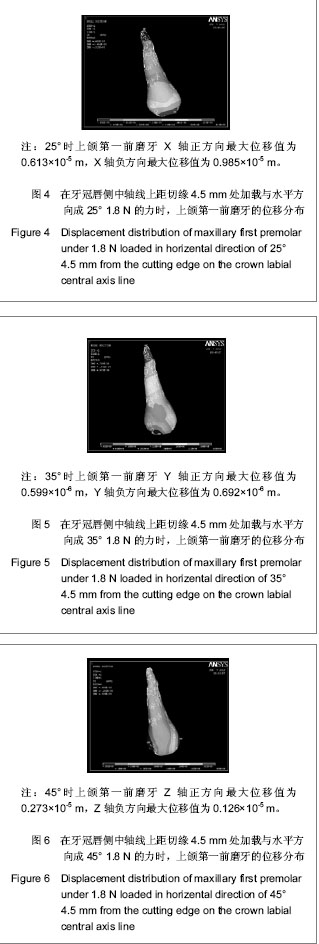| [1]Hu W,Xun CL,Qiu LX,et al. Kouqiang Zhengjixue. 2008;15(1):42-46.胡炜,寻春雷,邱立新,等. 利用种植体支抗压低修复前过长的后牙[J].口腔正畸学,2008,15(1):42-46.http://www.cnki.net/KCMS/detail/detail.aspx?QueryID=0&CurRec=1&recid=&filename=KQQZ200801015&dbname=CJFD2008&DbCode=CJFQ&urlid=&yx=[2]Ni ZY,Lin XP,Hu RD,et al. Kouqiang Yixue Yanjiu. 2005;21(4):435-437.倪振宇,林新平,胡荣党,等.应用微型种植体支抗压低磨牙[J].口腔医学研究,2005,21(4):435-437.http://www.cnki.net/KCMS/detail/detail.aspx?QueryID=4&CurRec=1&recid=&filename=KQYZ200504031&dbname=CJFD2005&DbCode=CJFQ&urlid=&yx=[3]Chen XM,Zhao YF. Beijing:Science Press,1996.陈新民,赵云凤.口腔生物力学[M].北京:科学出版社,1996.http://www.sciencep.com/[4]Lu XH,Ling JQ,Cai B,et al. Zhonghua Laonian Kouqiang Yixue Zazhi. 2003;1(4):200-201.卢新华, 凌均棨,蔡斌,等.下尖牙三维有限元模型的建立与应力分析[J].中华老年口腔医学杂志,2003,1(4):200-201.http://www.cnki.net/KCMS/detail/detail.aspx?QueryID=8&CurRec=1&recid=&filename=ZHKQ200304002&dbname=CJFD2003&DbCode=CJFQ&urlid=&yx=[5]Zhang T,Liu HC,Wang YR,et al. Zhonghua Kouqiang Yixue Zazhi. 2000;35(5):374-376.张彤,刘洪臣,王延荣,等.上颌骨复合体三维有限元模型的建立[J].中华口腔医学杂志,2000,35(5):374-376.http://www.cnki.net/KCMS/detail/detail.aspx?QueryID=12&CurRec=1&recid=&filename=ZHKY200005023&dbname=cjfd2000&DbCode=CJFQ&urlid=&yx=[6] Motoyoshi M, Hirabayashi M, Shimazaki T,et al. An experimental study on mandibular expansion: increases in arch width and perimeter. Eur J Orthod. 2002;24(2):125-130.http://www.ncbi.nlm.nih.gov/pubmed?term=An%20%20experimenta%20l%20%20study%20%20on%20%20mandibular%20%20%20expansion%EF%BC%9Aincreases%20in%20arch%20width%20and%20perimeter[7]Yan LJ,Liu HC,Bai L,et al. Kouqiang Hemian Xiufuxue Zazhi. 2002;3(3):149-151.阎黎津,刘洪臣,白露,等.下颌固定义齿的三维有限元模型的建立[J].口腔颌面修复学杂志,2002,3(3):149-151.http://www.cnki.net/KCMS/detail/detail.aspx?QueryID=16&CurRec=1&recid=&filename=KHXF200203005&dbname=cjfd2002&DbCode=CJFQ&urlid=&yx=[8]Li J,Yang DR,Dong FS,et al. Xiandai Kouqiang Yixue Zazhi. 2008;22(5):550,523.李健,杨冬茹,董福生,等. CT扫描结合 Mimics三维成像软件对上颌第二磨牙的三维重建[J]. 现代口腔医学杂志,2008,22(5):550,523.http://www.cnki.net/KCMS/detail/detail.aspx?QueryID=20&CurRec=1&recid=&filename=XDKY200805040&dbname=CJFD2008&DbCode=CJFQ&urlid=&yx=[9] McGuinness NJ, Wilson AN, Jones ML,et al. A stress analysis of the periodontal ligament under various orthodontic loadings. Eur J Orthod. 1991;13(3):231-242.http://www.ncbi.nlm.nih.gov/pubmed?term=A%20stress%20analysis%20of%20the%20periodontal%20ligament%20under%20various%20orthodontic%20loadings[10] Farah JW, Craig RG, Meroueh KA. Finite element analysis of three- and four-unit bridges. J Oral Rehabil. 1989;16(6):603-611.http://www.ncbi.nlm.nih.gov/pubmed/2689617[11] Langer B, Langer L, Herrmann I,et al. The wide fixture: a solution for special bone situations and a rescue for the compromised implant. Part 1. Int J Oral Maxillofac Implants. 1993;8(4):400-408.http://www.ncbi.nlm.nih.gov/pubmed?term=The%20wide%20fixture%3AA%20solution%20for%20special%20bone%20situations%20and%20rescue%20for%20the%20compromised%20implant.%20Part%201[12]He X,Tian LG,Mao YL,et al. Shanghai Kouqiang Yixue. 2011;20(3):321-323.何翔,田立国,毛永灵,等. 局部正畸联合微螺钉支抗在对颌牙伸长邻牙倾斜种植修复中的应用[J]. 上海口腔医学, 2011,20(3):321-323.http://www.cnki.net/KCMS/detail/detail.aspx?QueryID=24&CurRec=1&recid=&filename=SHKY201103033&dbname=CJFD2011&DbCode=CJFQ&urlid=&yx=[13] Zhang JW. Zhongguo Shequ Yishi. 2012;5(14):69.张金望.微螺钉种植体支抗在 Angle氏Ⅱ类牙颌畸形治疗中的临床应用[J].中国社区医师:医学专业, 2012,14(5):69.http://www.cnki.net/KCMS/detail/detail.aspx?QueryID=28&CurRec=1&recid=&filename=ZGSQ201205066&dbname=CJFD2012&DbCode=CJFQ&urlid=&yx=[14] Ohnishi H, Yagi T, Yasuda Y,et al. A mini-implant for orthodontic anchorage in a deep overbite case. Angle Orthod. 2005;75(3):444-452.http://www.ncbi.nlm.nih.gov/pubmed?term=.A%20%20mini-implant%20for%20%20orthodontic%20anchorage%20in%20a%20deep%20overbite%20%20case[15] Kim TW, Kim H, Lee SJ. Correction of deep overbite and gummy smile by using a mini-implant with a segmented wire in a growing Class II Division 2 patient. Am J Orthod Dentofacial Orthop. 2006;130(5):676-685.http://www.ncbi.nlm.nih.gov/pubmed?term=Correction%20%20of%20%20deep%20%20overbite%20%20%20and%20gummy%20%20smile%20%20by%20%20using%20%20a%20mini%20-implant%20%20with%20a%20segmented%20wire%20in%20a%20growing%20Class%20II%20Division%202%20%20patient[16] Upadhyay M, Nagaraj K, Yadav S,et al. Mini-implants for en masse intrusion of maxillary anterior teeth in a severe Class II division 2 malocclusion. J Orthod. 2008;35(2):79-89.http://www.ncbi.nlm.nih.gov/pubmed?term=for%20%20enmasse%20intrusion%20of%20maxillary%20%20anterior%20%20teeth%20in%20a%20severe%20%20%20Class%20II%20division%202%20%20malocclusio[17]Wang J,Ni LX,Ai L,et al. Shiyong Fangshexue Zazhi. 2006;22(5):535-536.王疆,倪龙兴,艾林,等.结合Micro-CT技术的上颌第一前磨牙三维模型的建立[J].实用放射学杂志,2006,22(5):535-536.http://www.cnki.net/KCMS/detail/detail.aspx?QueryID=32&CurRec=1&recid=&filename=SYFS200605008&dbname=cjfd2006&DbCode=CJFQ&urlid=&yx=[18] Jang SH, Kim WY. Defining a new annotation object for DICOM image: a practical approach. Comput Med Imaging Graph. 2004;28(7):371-375.http://www.ncbi.nlm.nih.gov/pubmed?term=Defining%20a%20new%20annotation%20object%20for%20DICOM%20image%EF%BC%9Aa%20practical%20approach[DOI]: http://www.medicalimagingandgraphics.com/article/S0895-6111(04)00081-3/abstract[19] Escott EJ, Rubinstein D. Free DICOM image viewing and processing software for your desktop computer: what's available and what it can do for you. Radiographics. 2003;23(5):1341-1357.http://www.ncbi.nlm.nih.gov/pubmed/12975521[20]Tong MJ,Hu DK. Guowai Yixue:Shengwu Yixue Gongcheng Fence. 1999;22(5):303-307.童明杰,胡大可. 认知医学数字图像通讯标准——DICOM [J].国外医学:生物医学工程分册,1999,22(5):303-307.http://www.cnki.net/KCMS/detail/detail.aspx?QueryID=36&CurRec=1&recid=&filename=GWSW199905009&dbname=cjfd1999&DbCode=CJFQ&urlid=&yx=[21]Wei HT,Zhang TF,Zeng CG,et al. Baiqiuen Yike Daxue Xuebao. 2000;26(2):150-151.魏洪涛,张天夫,曾晨光,等.牙颌三维有限元模型生成方法的探讨[J].白求恩医科大学学版,2000,26(2):150-151.http://www.cnki.net/KCMS/detail/detail.aspx?QueryID=40&CurRec=1&recid=&filename=BQEB200002023&dbname=cjfd2000&DbCode=CJFQ&urlid=&yx=[22] Mao XY,Qin YK,Wang ZY,et al. Huaxi Kouqiang Yixue Zazhi. 1996;14(4):299.毛祥彦,芩远坤,王政严,等. 全下颌牙种植义齿及支持组织应力的三维有限元分析──Ⅰ.三维有限元模型的建立[J].华西口腔医学杂志,1996,14(4):299.http://www.cnki.net/KCMS/detail/detail.aspx?QueryID=44&CurRec=1&recid=&filename=HXKQ604.018&dbname=CJFD1996&DbCode=CJFQ&urlid=&yx=[23]Yi L,Zhang N,Zhao SL,et al. Zhongguo Meirong Yixue. 2007;16(4):494-496.怡力,张娜,赵守亮,等. 下颌第一磨牙三维有限元模型的建立[J]. 中国美容医学, 2007,16(4):494-496.http://so.med.wanfangdata.com.cn/ViewHTML/PeriodicalPaper_zgmryxzz200704024.aspx[24]Shi JN. Beijing:Higher Education Press. 2000:166-168.史俊南.现代口腔内科学[M].北京:高等教育出版社,2000:166-168. http://www.hep.com.cn/portal/product/index?bk=15878-00[25]Cheng GD. Beijing:Science Press. 1989:123-129.程耿东.有限元法的概念和应用[M].北京:科学出版社,1989:123-129. http://www.sciencep.com/[26] Li N,Zhang Y. Zhongguo Shequ Yishi, 2010;12(14):121.李娜,张扬.上颌第一磨牙及其支持组织三维有限元模型的建立[J].中国社区医师:医学专业,2010,12(14):121.http://www.cnki.net/KCMS/detail/detail.aspx?QueryID=56&CurRec=2&recid=&filename=ZGSQ201014133&dbname=CJFD2010&DbCode=CJFQ&urlid=&yx=[27] Zhang H,Wang DW,Zhu SL,et al. Zhongshan Daxue Xuebao:Yixue Kexue Ban. 2006;27(z2):11-13.张弘,王大为,朱双林,等. 不同方向加载力移动上颌尖牙的三维有限元分析[J]. 中山大学学报:医学科学版,2006,27(z2):11-13.http://www.cnki.net/KCMS/detail/detail.aspx?QueryID=60&CurRec=1&recid=&filename=ZSYK2006S2006&dbname=CJFD2006&DbCode=CJFQ&urlid=&yx=[28] Fritz U, Ehmer A, Diedrich P.Clinical suitability of titanium microscrews for orthodontic anchorage-preliminary experiences. J Orofac Orthop. 2004;65(5):410-418.http://www.ncbi.nlm.nih.gov/pubmed?term=Clinical%20suitability%20of%20titanium%20microscrews%20for%20orthodontic%20anchorage-preliminary%20experiences[29] Motoyoshi M, Yano S, Tsuruoka T,et al. Biomechanical effect of abutment on stability of orthodontic mini-implant. A finite element analysis. Clin Oral Implants Res. 2005;16(4):480-485. http://www.ncbi.nlm.nih.gov/pubmed?term=Biomechanical%20effect%20of%20abutment%20on%20stability%20of%20orthodontic%20mini-implant%EF%BC%8EA%20finite%20element%20analysis[30]Jin SM,Wang XX,Zhang LN,et al. Shandong Daxue Xuebao:Yixueban. 2010;48(12):67-74.靳淑梅,王旭霞,张丽娜,等.不同工况下埋伏牙的位移趋势及牙周应力的三维有限元分析[J]. 山东大学学报:医学版,2010,48(12):67-74.http://www.cnki.net/KCMS/detail/detail.aspx?QueryID=64&CurRec=1&recid=&filename=SDYB201012016&dbname=CJFD2010&DbCode=CJFQ&urlid=&yx=[31]Zhu SJ,Zhou YH,Fu MK,et al. Kouqiang Zhengjixue. 2007;11(4):169-173.朱胜吉,周彦恒,傅民魁,等. 应用种植体支抗正畸治疗的初步临床研究[J].口腔正畸学,2007,11(4):169-173.http://so.med.wanfangdata.com.cn/ViewHTML/PeriodicalPaper_kqzjx200404007.aspx |



.jpg)